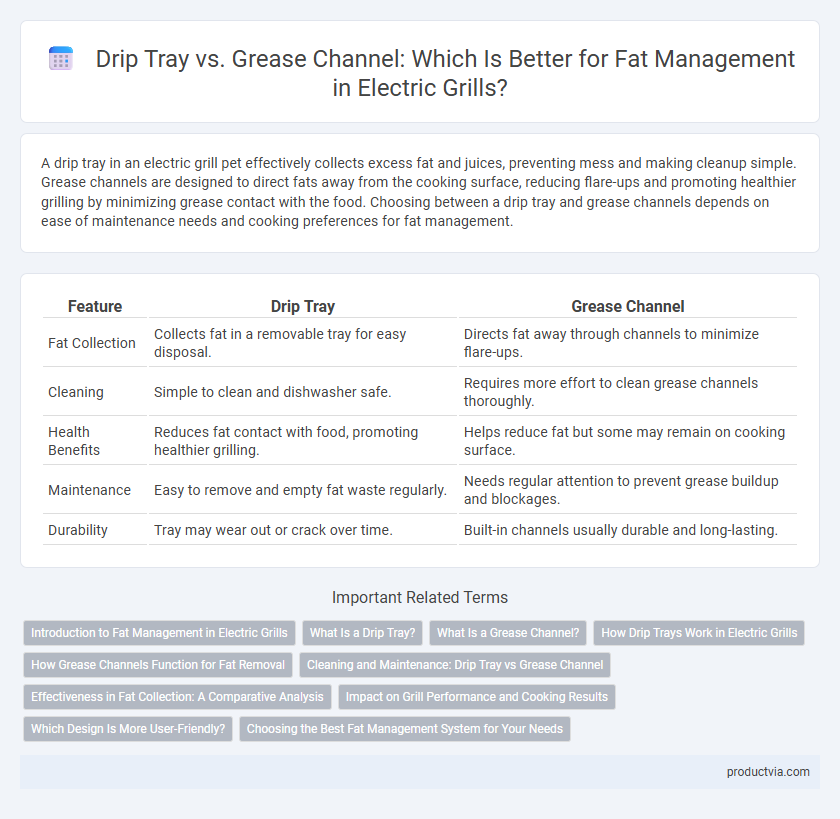A drip tray in an electric grill pet effectively collects excess fat and juices, preventing mess and making cleanup simple. Grease channels are designed to direct fats away from the cooking surface, reducing flare-ups and promoting healthier grilling by minimizing grease contact with the food. Choosing between a drip tray and grease channels depends on ease of maintenance needs and cooking preferences for fat management.
Table of Comparison
| Feature | Drip Tray | Grease Channel |
|---|---|---|
| Fat Collection | Collects fat in a removable tray for easy disposal. | Directs fat away through channels to minimize flare-ups. |
| Cleaning | Simple to clean and dishwasher safe. | Requires more effort to clean grease channels thoroughly. |
| Health Benefits | Reduces fat contact with food, promoting healthier grilling. | Helps reduce fat but some may remain on cooking surface. |
| Maintenance | Easy to remove and empty fat waste regularly. | Needs regular attention to prevent grease buildup and blockages. |
| Durability | Tray may wear out or crack over time. | Built-in channels usually durable and long-lasting. |
Introduction to Fat Management in Electric Grills
Fat management in electric grills is crucial for healthier cooking and easy cleanup, involving two primary systems: drip trays and grease channels. Drip trays collect excess fat and juices beneath the cooking surface, preventing flare-ups and reducing smoke, while grease channels direct fat away from the food into designated reservoirs. Choosing the right fat management system enhances grilling efficiency and maintains optimal cooking conditions.
What Is a Drip Tray?
A drip tray is a removable container integrated into an electric grill designed to catch excess fat and juices that drip from food during cooking, ensuring cleaner grilling and easier maintenance. Unlike grease channels that redirect fat away from the heat source, drip trays collect and contain these liquids in one place, preventing flare-ups and reducing smoke. High-quality drip trays are typically made of non-stick materials for effortless cleaning and contribute significantly to healthier grilling by reducing fat contact with heating elements.
What Is a Grease Channel?
A grease channel in an electric grill is a specifically designed groove or pathway that directs excess fat and oils away from the cooking surface to a designated collection area. Unlike a drip tray, which simply collects grease at the bottom of the grill, the grease channel efficiently channels liquid fats, preventing flare-ups and promoting healthier cooking by reducing fat exposure to heat. This method improves cleanliness, simplifies grease disposal, and enhances overall grilling performance.
How Drip Trays Work in Electric Grills
Drip trays in electric grills collect excess fat and grease that drains from food during cooking, preventing flare-ups and reducing smoke. Positioned beneath the grill surface, drip trays capture liquids efficiently, making cleanup easier and maintaining healthier cooking conditions. This fat management system contrasts with grease channels, which direct grease away from heat but may be less convenient for removal and cleaning.
How Grease Channels Function for Fat Removal
Grease channels in electric grills are designed to direct excess fat and oils away from the cooking surface into a dedicated drip tray, preventing flare-ups and promoting healthier cooking. These channels are strategically angled to utilize gravity for efficient fat flow, reducing smoke production and making cleanup easier. By separating grease from food, grease channels help maintain optimal cooking temperatures and enhance food flavor by preventing fats from accumulating and burning on the grill.
Cleaning and Maintenance: Drip Tray vs Grease Channel
Drip trays offer easier cleaning and maintenance by collecting grease in a removable container that can be quickly emptied and washed. Grease channels require more frequent attention to prevent blockages, often needing manual scraping and rinsing to maintain optimal performance. Choosing a drip tray simplifies fat management and reduces overall cleanup time for electric grills.
Effectiveness in Fat Collection: A Comparative Analysis
Drip trays capture excess fat by providing a flat surface for grease to pool, making them easy to clean but often less efficient at preventing fat from pooling under food. Grease channels use angled grooves to direct fat away from the cooking surface into a collection reservoir, enhancing fat removal and reducing flare-ups. Comparative analysis shows grease channels generally offer more effective fat management by continuously channeling grease away, improving both cooking hygiene and food quality.
Impact on Grill Performance and Cooking Results
A drip tray effectively collects excess fat away from the cooking surface, reducing flare-ups and promoting consistent heat distribution, which enhances grill performance and prevents food from becoming overly greasy. Grease channels guide fat away more directly but can sometimes cause flare-ups if not properly designed, potentially impacting cooking evenness and safety. Selecting a well-designed fat management system optimizes heat control and flavor retention, resulting in evenly cooked, healthier grilled food.
Which Design Is More User-Friendly?
Drip trays offer a straightforward approach to fat management by collecting excess grease in a removable container, making cleanup simple and less messy for users. Grease channels, integrated into the grill surface, direct fat away from food but may require more effort to clean, potentially trapping residue in narrow grooves. For ease of maintenance and user-friendliness, drip trays generally provide a more convenient solution in electric grills.
Choosing the Best Fat Management System for Your Needs
Selecting the ideal fat management system depends on cooking habits and maintenance preferences, with drip trays offering easy cleanup by collecting excess fat in a removable container. Grease channels provide continuous fat drainage, reducing flare-ups and enhancing cooking safety but may require more frequent cleaning. Evaluating factors like grease capacity, ease of disposal, and grill design ensures optimal performance and convenience tailored to user needs.
Drip tray vs grease channel for fat management Infographic

 productvia.com
productvia.com